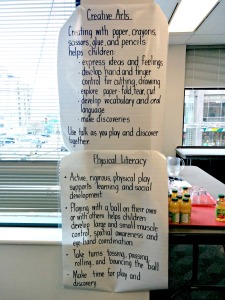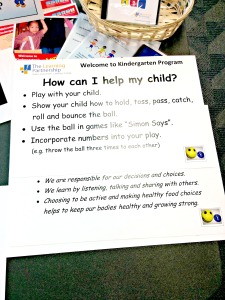The expression most commonly used to describe my story time style is “high energy”. Children attending my programs spend most of our thirty minutes together in motion – singing, clapping their hands, tapping their toes, dancing, jumping, marching and moving their bodies. As anyone who has worked with children knows, they are designed to move!
It seems that I’m not the only one who believes in the importance of movement in early literacy. The “Welcome to Kindergarten” program has introduced a new station that emphasizes what they call “physical literacy”. The station uses a simple ball to show parents how easily movement can be introduced into their child’s play to help build and strengthen a number of different skills and abilities.
As librarians, teachers and early childhood educators know, movement supports the development of muscle strength and control, hand-eye coordination, balance, and fine motor skills. Physical games and activities can help children learn to share and take turns, and engage in cooperative play. Beyond the physical benefits of movement, children who engage in active learning have opportunities to practice following directions, build listening skills, develop vocabulary, enhance alphabet and number awareness and strengthen pattern recognition – all while having fun!
I like to incorporate physical literacy into every story time, but particularly when working with active, energetic toddlers and preschoolers. Rather than attempting to force children to sit still for long periods of time, which works against their natural inclination towards movement, I believe in channeling that energy into positive, educational activities that encourage active learning. Here are just a few examples of ways in which physical literacy can become a part of your story times:
This fun little ditty, which can also be used as a baby lap bounce, gets kids singing and jumping while practicing their counting skills.
“Here we go a-marching”
I couldn’t find a recording of this song, but the lyrics are pretty simple, and you can sing them to any tune you like! Here are just a few of the variations I typically do with my group.
Here we go a marching, marching, marching!
Here we go a marching, and then we stop!
Here we go a jumping, jumping, jumping!
Here we go a jumping, and then we stop!
Here we go a driving, driving, driving, driving!
Here we go a driving, and then we stop!
Here we go a flying, flying, flying!
Here we go a flying, and then we stop!
Here we go a swimming, swimming, swimming!
Here we go a swimming, and then we stop!
Children practice following directions in this fun, energetic song, stopping whatever action they’re doing when the leader says “stop!” I like to incorporate the ASL sign for “stop” into the song, and add as many verses as I feel fits the day’s energy levels!
This story time classic uses movement to reinforce vocabulary, helping children visualize opposites such as out and in, and up and down.
One of my absolute favourites, and a must for any story time I do! Energetic fun for all ages that gets kids jumping up and down, following directions and reinforcing opposites. Songs with actions help children learn to follow directions. It’s also just about the most fun you can have in a story time. If you haven’t take the elevator up and down with your story time crew yet, you don’t know what you’re missing!
“If You’re Happy and You Know It”
Another classic song that’s perfect for helping children practice following directions, as well as providing opportunities for vocabulary development. I like to include a wide range of different body parts when singing this song – children pat their heads, stick out their tongues, touch their toes, wiggle their ears, blink their eyes, tickle their elbows, and more! It’s also an ideal transition song – I can use it to get children to sit back down, line up, grab their backpacks, or do whatever else I need them to do – following directions is so much more fun when the directions are sung!
I really believe in actve, engaging story times that recognize the many different ways in which children learn. I also believe that story times should be fun – for children and librarians! What are some of your favourite ways to get kids moving and learning in story times?

